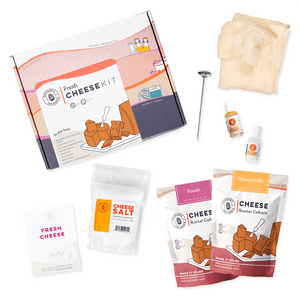
This fresh, small-curd cheese can be used in recipes in lieu of cottage cheese or mixed with herbs and spread on homemade wheat crackers. Simple and easy, this delicious cheese can be kept in the refrigerator for quick, healthy snacking. Farmer cheese is also called pot cheese, because colonial American women used to keep in a pot next to the cook stove until they needed it.
15 minutes
180 minutes
2
INGREDIENTS AND EQUIPMENT AVAILABLE AT CULTURES FOR HEALTH
Fresh Cheese Making Kit

Fresh Cheese Making Kit
$45.99
Our most comprehensive choice, the Fresh Cheese Kit contains two starter cultures and supplies to make five different varieties of soft cheese - feta, cottage cheese, cream cheese, fromage blanc, and traditional quark. Kit contains a Mesophilic Cheese Culture, a Fresh Cheese Culture, calcium chloride, vegetable rennet, cheese salt, butter muslin, a thermometer, and an instruction and recipe card.
Packaging and Equipment in the kit may appear different than pictured.
Mesophilic Direct-Set Starter Culture

Mesophilic Direct-Set Starter Culture
$19.99
From cheddar, Colby, and Monterey Jack to Feta, Chevre, and more, you'll enjoy the flavor and variety of homemade cheeses made using this starter culture.
Cheese Salt

INGREDIENTS:
- 1 gallon whole milk
- 1 packet direct-set mesophilic culture
- 1-2 Tbsp. heavy cream
- Cheese salt
INSTRUCTIONS:
- In a large cheese pot, heat the milk to 72°F.
- Add the starter and mix it in using slow, steady up-and-down motions for one minute. If using fresh cow milk, top-stir for 30 seconds more. Cover and allow it to set for 18-24 hours. The curd will be soft.
- Cut the curd into 1/4-inch cubes. Cover and let them set for 10 minutes.
- Bring the heat up by 1°F each minute until the temperature of the curds reaches 100°F. Stir gently every now and then to keep curds from matting or sticking together. Maintain the temperature for 10 minutes, continuing to stir occasionally.
- Increase the temperature to 112°F very slowly. This should take around 15 minutes. Once the curds have reached 112°F, keep them at that temperature for 30 minutes, or until the curds have solidified a bit more, making them firm to the touch. If they haven’t gotten more solid after 30 minutes, keep cooking and don’t go to the next step until the curds have lost their custard-like consistency.
- Let the curds settle to the bottom of the cheese pot, about 5 minutes.
- Drain off the whey until you can see the curds. Line a colander with clean butter muslin and pour the curds into it, catching the whey in a bowl underneath. For less sour farmer cheese, gather the edges of the butter muslin and pick the whole bundle up like a sack, dip the bag of curds into cold, clean water a few times, then continue with draining as usual.
- Drain curds for several minutes, then put the sack of curds into a sink of ice water to cool them rapidly. Drain for several minutes more.
- Pour the curds from the butter muslin sack into a bowl, and toss them with the cheese salt, adding more according to taste. Stir in the cream now, if desired, to lend the cheese a creamier texture.
Store farmer cheese in a covered container in the refrigerator for up to 1 week.
















